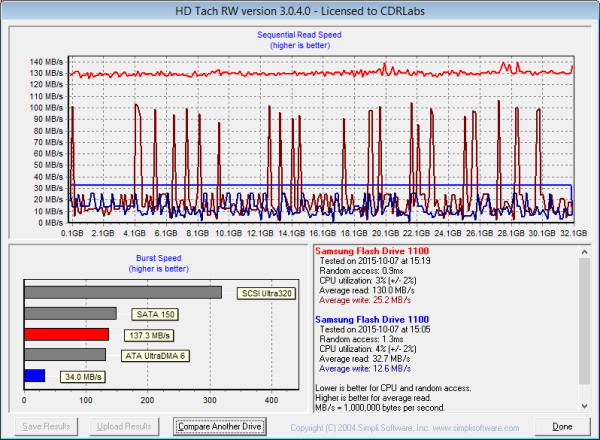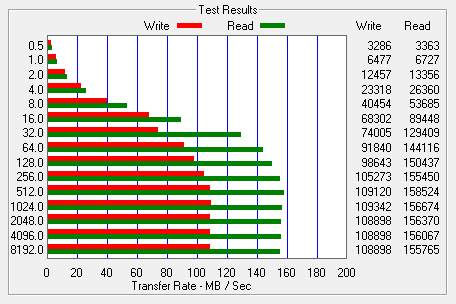Performance:
The test system used in this review was an HP 8200 Elite. The computer is equipped with an Intel Core i5-2400 CPU, 4GB of DDR3 1333MHz memory, Seagate Barracuda 7200.12 ST3250312AS 250GB SATA 6 Gb/s hard drive, NVIDIA Quadro FX580 512MB PCIe graphics card, Intel 82567LM-3 gigabit network card and Patriot SuperSpeed USB PCIe host card. For the operating system, I installed a fresh copy of Windows 8.1 Enterprise.
To test the performance of the Samsung Bar, I ran a series of benchmarks using CrystalDiskMark 3.0.1, HD Tach RW 3.0.4.0 and ATTO Disk Benchmark 2.46. To get a feel for the "real world" performance, I also copied and pasted 500MB of random files and directories in Windows Explorer.
CrystalDiskMark 3.0:
First, I ran a few quick tests using CrystalDiskMark. This benchmark tool measures the performance of a storage device by testing its sequential read and write speeds as well as its random read and write speeds using blocks 512K and 4K in size.
According to Samsung, the Bar is capable of data transfer speeds of up to 130 MB/s when connected to a USB 3.0 port. While the drive performed better than expected when reading, it came up a bit short of this number in CrystalDiskMark's sequential write test.
HD Tach RW 3.0.4.0:
Next, I used HD Tach to test the Bar's read, write and burst speeds as well as its seek times and CPU usage.

The Bar didn't perform quite as well when tested with HD Tach. Looking at the screenshot above, you can see that the drive had average read and write speeds of 130.0 MB/s and 25.2 MB/s, respectively, as well as a burst speed of 137.3 MB/s.
ATTO Disk Benchmark 2.46:
I also used ATTO Disk Benchmark to test the Bar's sequential read and write speeds. The test was run using blocks ranging in size from 0.5KB to 8192KB and the total length set to 256MB.
When tested with ATTO, the Bar's read speeds topped out at about 158 MB/s and its write speeds at 109 MB/s.
"Real World" Benchmark:
To test the "real world" performance of Samsung's new flash drive, I copied and pasted 500 MB worth of randomly generated files and directories. All of the files are between 10 bytes and 32MB in size and no more than four directories deep.
| Samsung Bar - USB 3.0 | Samsung Bar - USB 2.0 | |
| Write: | 34 seconds | 59 seconds |
| Read: | 9 seconds | 22 seconds |
The Bar performed relatively well here, taking 34 seconds to write our test data and 9 seconds to read it back.
Final Thoughts:
Samsung's Bar USB 3.0 flash drive is a great addition to the company's already impressive line of flash-based storage products. Instead of looking like your standard, run of the mill flash drive, the Bar sports a unique, yet functional design. The drive is equipped with a high-quality, metal casing that is water, shock, temperature, magnetic and X-ray proof. The streamlined spherical end also makes it easy to insert and extract the drive from devices and can be used to attach your key ring. Performance-wise, the Bar wasn't the fastest USB 3.0 flash drive to come through the 'Labs. Nevertheless, the drive performed relatively well in our tests, reading at speeds as high as 159 MB/s and writing at more than 109 MB/s.
The Samsung Bar is available now in 16GB, 32GB, 64GB capacities. Prices on Amazon.com currently range from $9 up to $23, with the 32GB version reviewed here going for about $13.
Highs:
- Great looking design
- High-quality metal casing
- Good read and write speeds
- Backwards compatible with USB 2.0
- Water, shock, temperature, magnetic, and x-ray proof
- Large key ring hole
- Five year warranty
- Reasonably priced
Lows:
- None





